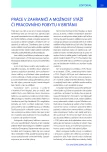PROGNOSTIC SIGNIFICANCE OF PARAMETERS ARISING FROM THE RATIO OF NEUTROPHILS AND LYMPHOCYTES IN INVASVIE BLADDER NEOPLASMS
Authors:
Natália Marečková 1; Michal Staník 1; Ivo Čapák 1; Daniel Macík 1; Jiří Jarkovský 2; Denisa Malúšková 2; Jan Doležel 1
Authors‘ workplace:
Oddělení onkourologie, Masarykův onkologický ústav, Brno
1; Institut biostatistiky a analýz, Masarykova univerzita, Brno
2
Published in:
Ces Urol 2016; 20(4): 293-301
Category:
Original Articles
Overview
Major statement:
Elevated lymphocyte to neutrophile ratio as a marker of systemic inflammation, was confirmed as negative predictors of cancer-specific survival in the group of 110 patients, who underwent radical cystectomy for invasive urothelial carcinoma of urinary bladder.
Aims:
The aim of our study was to investigate the prognostic impact of the longitudinal monitoring of markers of systemic inflammation neutrophil-to-lymphocyte ratio (NLR, derived NLR) in patients undergoing radical cystectomy.
Patients and methods:
In the period 2006. 2014 110 patients with bladder cancer underwent radical cystectomy without neoadjuvant chemotherapy. Results of blood count before, and 3.5 months after surgery, and at the time of diagnosis of relapse, were obtained retrospectively, and parameters of NLR and dNLR were analyzed. Patients were divided in two groups according to the NLR and dNLR with the cut-off values of 3.9 and 2.7 respectively. The prognostic impact of these parameters on patientse survival was assessed.
Results:
Postoperative elevation od both NLR and dNLR was a negative predictor of cancer-specific survival. Five year cancer-specific survival was 64 % in patients with NLR . 3.9 compared to 42 % in those with NLR > 3.9 (HR 2.0; p=0.043). Similarly, in case of dNLR, with the cut-off value of 2.7, the survival rates in the groups were 63% and 30% respectively (HR 3.7; p=0.002). Pre-operative values of both parameters showed no prognostic significance. At the time of relapse, higher values of NLR and dNLR were associated with shorter survival (median 4 and 3 months compared to 14 and 12 months).
Summary:
Markers of systemic inflammation showed promising results in identifying high-risk patients before surgery, as well as in follow-up. In the case of relapse, they can be helpful in prognosis prediction. In our study, the values of both NLR and dNLR obtained 3 months after surgery were of most importance, with the ability to identify the group of patients in statistically significant risk of disease progression.
Key words:
Biomarkers, prognosis, inflammation, urinary bladder neoplasms.
Sources
1. Siegel R, Naishadham D, Jemal A. Cancer statistics, 2013. CA Cancer J Clin 2013; 63 : 11–30.
2. Dinney CP. Therapy of invasive bladder cancer. Urology 2006; 67(Suppl 1): 56–59.
3. Malkowicz SB, van Poppel H, Mickisch G, et al. Muscle-invasive urothelial carcinoma of the bladder. Urology 2007; 69 : 3–16.
4. Zehnder P, Studer UE, Skinner EC, et al. Unaltered oncological outcomes of radical cystectomy with extended lymphadenectomy over three decades. BJU Int 2013; 112: E51–8.
5. Hanahan D, Weinberg RA. Hallmarks of cancer: the next generation. Cell 2011; 144(5): 646–674.
6. Grivennikov S, Greten FR, Karin M. Immunity, inflammation, and cancer. Cell 2010; 140(6): 883–899.
7. Gondo T, Nakashima J, Ohno Y, et al. Prognostic value of neutrophil-to-lymphocyte ratio and establishment of novel preoperative risk stratification model in bladder cancer patients treated with radical cystectomy. Urology 2012; 79 : 1085–1091.
8. Templeton AJ, McNamara MG, Šeruga B, et al. Prognostic role of neutrophil-to-lymphocyte ratio in solid tumors: a systematic review and meta-analysis JNCI J Natl Cancer Inst 2014; 106: dju124.
9. Hu Q, Gou Y, Sun C, et al. The prognostic value of C-reactive protein in renal cell carcinoma: a systematic review and meta-analysis. Urol Oncol 2014; 32 : 50.e1–8.
10. Viers BR, Boorjian SA, Frank I, et al. Pretreatment neutrophil-to-lymphocyte ratio is associated with advanced pathologic tumor stage and increased cancer-specific mortality among patients with urothelial carcinoma of the bladder undergoing radical cystectomy. Eur Urol 2014; 66(6): 1157–1164.
11. Kawahara T, Furuya K, Nakamura M, et al. Neuthrophil-to-lymphocyte ratio is a prognostic marker in bladder cancer patients after radical cystectomy. BMC Cancer 2016; 16 : 185.
12. Marchioni M, Primiceri G, Ingrosso M, et al. The clinical use of the neutrophil to lymphocyte ratio (NLR) in urothelial cancer: a Systematic review. Clin Genitourin Cancer 2016; pii: S1558–7673(16)30098–2: v tisku.
13. Cho H, Hur HW, Kim SW, et al. Pre-treatment neutrophil-to-lymphocyte ratio is elevated in epithelial ovarian cancer and predicts survival after treatment. Cancer Immunol Immunother 2009; 58 : 15–23.
14. McMillan DC. Systemic inflammation, nutritional status and survival in patients with cancer. Curr Opin Clin Nutr Metab Care 2009; 12(3): 223–226.
15. Krane LS, Richards KA, Kader AK, et al. Preoperative neutrophil/lymphocyte ratio predicts overall survival and extravesical disease in patients undergoing radical cystectomy. J Endourol 2013; 27 : 1046–1050.
16. Kang M, Jeong CW, Kwak C, Kim HH, Ku JH. The prognostic significance of the early postoperative neutrophil.to.lymphocyte
ratio in patients with urothelial carcinoma of the bladder undergoing radical cystectomy Ann Surg Oncol 2016; 23(1): 335.342.
17. Azab B, Jaglall N, Atallah JP, et al. Neutrophil.lymphocyte ratio as a predictor of adverse outcomes of acute pancreatitis Pancreatology 2011; 11(4): 445.452.
18. He J, Li J, Wang Y, Hao P, Hua Q. Neutrophil.to.lymphocyte ratio (NLR) predicts mortality and adverse.outcomes after ST.segment elevation myocardial infarction in Chinese people Int J Clin Exp Pathol 2014; 7(7): 4045.4056.
Labels
Paediatric urologist Nephrology UrologyArticle was published in
Czech Urology

2016 Issue 4
Most read in this issue
- PROGNOSTIC SIGNIFICANCE OF PARAMETERS ARISING FROM THE RATIO OF NEUTROPHILS AND LYMPHOCYTES IN INVASVIE BLADDER NEOPLASMS
- BLADDER SPARING TREATMENT FOR MUSCLE-INVASIVE BLADDER CANCERS
- URINARY SYMPTOMS IN PATIENTS WITH MULTIPLE SCLEROSIS. AS UROLOGISTS, ARE WE IMPORTANT IN THE ALGORITHM OF SPECIALIZED CARE OF PATIENT WITH MULTIPLE SCLEROSIS?
- RECOMMENDATIONS FOR DIAGNOSIS AND MANAGEMENT OF NOCTURIA IN THE CZECH REPUBLIC
